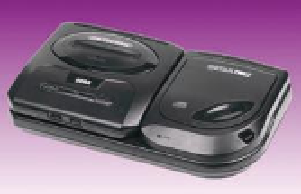Game Development Reference
In-Depth Information
Sega Genesis
Sega, a Japanese and American maker of arcade games, got into the
console business around the same time as Nintendo, and experienced
moderate success until the debut of the Genesis (also called the Sega
Mega Drive in Japan) in 1988, before the SNES came out. The Genesis,
similar in some ways to the SNES, featured even less memory capacity
with total of 64KB of RAM and only 8KB of dedicated sound RAM. Still,
sound quality wise, it represented a signii cant step up, as it featured a
Yamaha FM chip with some built-in sounds, and 6 stereo audio channels.
The Sega CD was an add-on to the Genesis
Console, though it later came bundled
together. This combination created one of
the i rst consoles to feature CD-ROM media,
greatly enhancing audio and musical content
in addition to higher quality graphics and
animations.
Credit:
Evan Amos.
Sega CD Released
In 1992, another huge advance took place when Sega released the $299
Sega CD system. The console itself was very similar to the Genesis in
power, but the big dif erence was the inclusion of a 500 MB
CD-ROM
disc.
This was a huge jump in storage capacity and allowed developers to add
high-end graphics, and of course high-end sound if desired. The SEGA
CD also included a total of 18 sound channels, a sample rate of 44.1 KHz
and separate audio outputs for connecting to a household stereo system.
All this along with the FM General MIDI-compatible chip set made for a
lot of new sonic possibilities.
A Sega CD game of this period typically might have a series of fully
produced opening cutscenes, multiple levels of gameplay with a
background MIDI score, some number of 16-bit, stereo audio tracks
(as much as the producer would allow, depending on sound budget),
hundreds if not thousands of individual sound ef ects, and many many
lines of voice-over. You can see that this is a gigantic improvement on
the 3-voice NES! All this audio from these various sources had to be
mixed and blended together to sound good in the game, which was no
small task.
N64 and Game Cube
Nintendo, in a heated competition with Sega for dominance of the home
console market, continued to update its game machines throughout
the years. First in 1996 with the Nintendo 64, then in 2001 with the
Gamecube. The 64 was a beefed-up, cartridge-based 64-bit system and
the Cube was optical disc based. Both had a huge selection of games and
audio technology was getting better and making it possible to include
more music, sound ef ects and voice-over than ever before.


































